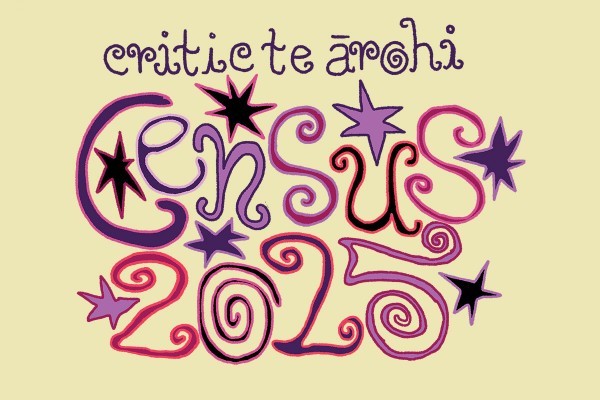Disclaimer: AI was used as a data analysis tool in the research for this article.
The Critic Te Ārohi census is back for its fifth year. What originally began as thinly veiled nosiness has morphed into an annual data-gathering exercise, tracking the trends of the fine specimen we call the Otago student.
As the years have gone on, Critic’s become even nosier. Our need to peer into the lives of students has progressed past the binoculars you’d find on your grandad’s windowsill to a NASA-scale motherfucker. From the rise of ChatGPT use as a “search engine”, the uptake in Ritalin as a recreational drug, consistent superiority of Central Library and support for the Greens, a slow but steady increase in rental prices, and the beef over flat dishes – here’s the tea on what’s hot and what’s not among your peers.
Who completed the census?
681 of you patient souls completed this year’s census, which we realised was no easy feat after watching a student fill it out over the space of an hour. This was in between the arguments over whether pineapple belongs on pizza, the Rice Purity test you had to retake, and paragraphs to write on complex geopolitical issues if you so fancied. Genuinely, thank you for taking the time. And valid to those who typed “idk” by the 78th question as your coffee grew cold (173 in total).
Our numbers were less than last year’s 1005 which provided a fairly accurate representation of the student body regarding proportions of age groups, gender and ethnicity. That was the result of social media plugs, magazine advertising, QR code postering on campus, and lecture bashing. We couldn’t be fucked going that hard this year – a big semester of birthday celebrations left us weighed down with cake – so this year was the accumulation of social media and mag ads. Based on the most popular answers, the average census respondent was a straight Pākeha agnostic third-year female science student from Otago whose celebrity crush is Pedro Pascal (check out the pie charts for a breakdown).
Sex & Relationships
The Capping Show this year portrayed the North D student experience as an orgasmic landscape where car windows aren’t just foggy from the cold, and chances are your boyfriend is in the closet. Critic’s census debunks the hetero hook-up culture stereotype of breathas and beezies swapping saliva on Flatpack beds. Only half of students identified as straight and 52.6% of students are having sex every few months at most. Unsurprisingly, students’ relationship statuses were the biggest influence on how often they had sex.
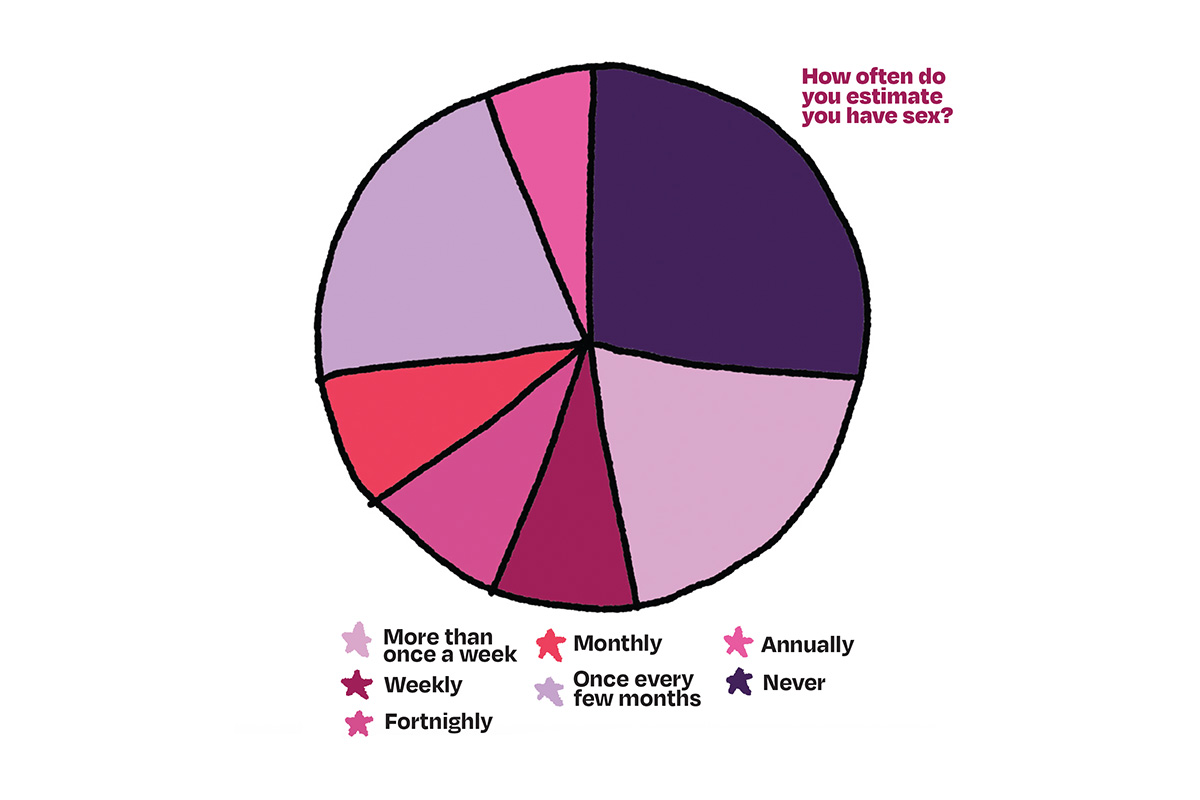
Half of students in the census were single, none of whom reported having sex more than once a week. The majority of singles have no sex at all (26.9%) (“practicing semen retention” as one person put it), some citing healing from a break-up as the reason. Others celebrate an annual romp in the sheets (9%) or have sex once every few months (16.7%) when they redownload Tinder (used by 41% of respondents). The next most popular dating apps when the craving resurfaces are Hinge (28%), Bumble (10.7%) and Grindr (4.6%) – including the person whose relationship status is simply “lonesome gay yearning”. Critic suggests to the person who’s still sleeping with their ex despite having all of the dating apps to actually use them.
Adorably, an equally high proportion of students as those who are “neutrally single” (35.5%) also reported being in a relationship with the person they thought might be “the one” (27.8%). Critic could not confirm whether this was influenced by couples taking the survey together – which could have affected the stat of 49.8% of students who “don’t consume porn”. While couples were most likely to be getting dicked down on the regular, not all are pashing in the Rob Roy line. Those in less happy relationships (either “neutral” or “negative”) tended to report having less sex than the love birds. Those going steady (8.2%) had a mixed bag, ranging from more than once a week to never, which could be a product of long distance, an overactive Satisfyer Pro and Pornhub in an incognito tab (among 34% who use the site). Critic’s thoughts and prayers are with the students who either admitted to being in a doomed relationship, or are in the trenches of situationships – 19 with someone who just won’t commit (boo) and 30 are on their way to being locked down (yay). With 64.5% saying they've been in love before (13.2% were unsure) it seems hope is not lost for romance at Otago.
Rice Purity
Remember that list of 100 questions everyone became obsessed with in high school to test how “pure” you were? We asked students to retest themselves to see how their scores had plummeted since learning how to smoke cones behind your hall and popping your cherries. Results showed an average score of 50.9, meaning most of y’all have danced without leaving room for Jesus and fondled a buttocks or two, but not gone so far as to do meth or commit incest. Good on you. To make things more interesting, we measured how dirty each degree was: Arts students are the freakiest among us (av. 39), Law students are getting their wild days out the way before committing to the straight-laced lifestyle (av. 44), and we can be rest assured that the teachers of our future kids are the purest of them all (av. 58).
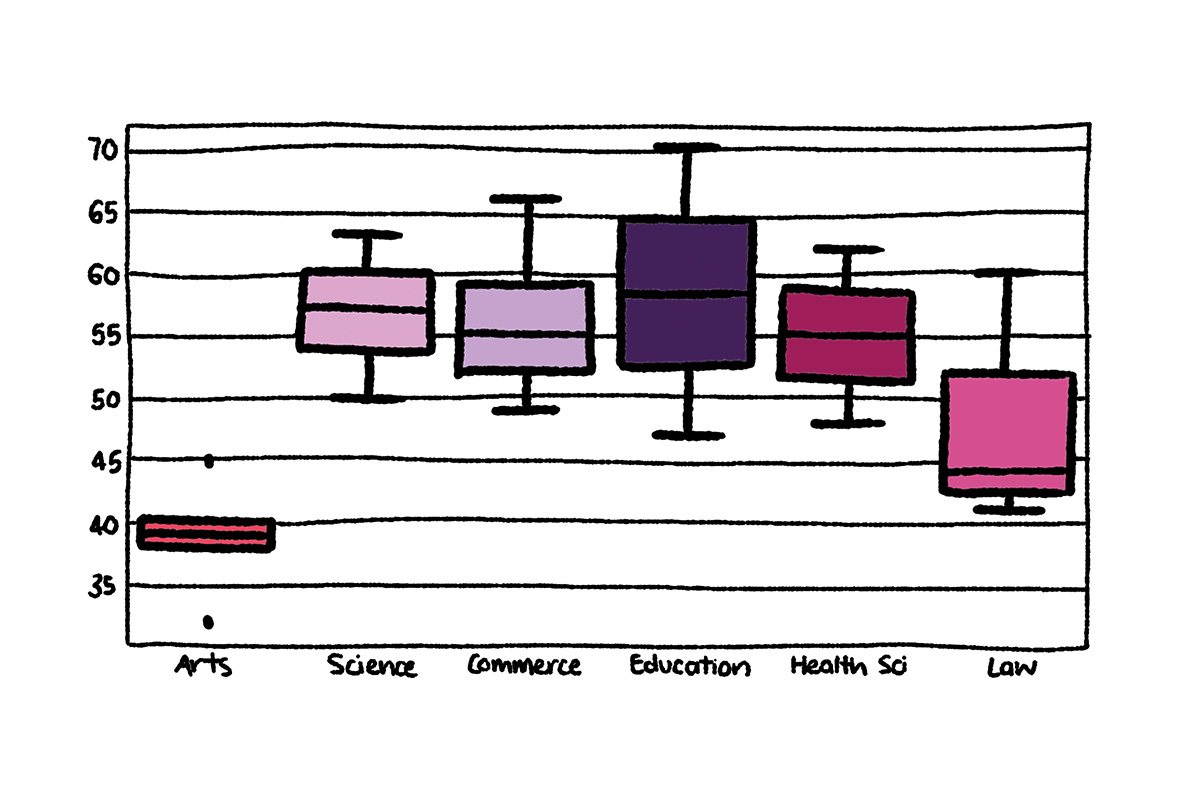
University & Academia
Otago Satisfaction
The University of Otago is equally as renowned for its academic prestige and gorgeous grounds as its thriving campus and wild student life. The darker underbelly of party culture can often attract some heat in the media, and there’s been plenty of upset over courses cut to plug financial holes, but 91.5% of students in the census reported being happy with their choice to study in Dunedin. Thankfully, given many are from the North Island (52.2%) and flights are expensive.
Halls
Halls of residence each come with a unique culture, stereotype and traditions, spurring a loyalty in students that’ll have second-year Salmond residents protesting an “unfair” food review even though they no longer live there. Interestingly, despite there being a reputation of some halls being more aligned with certain subjects (e.g., Carrington for HSFY) there was an even spread of degrees across the halls. The 89 students who wished they went to a different hall had gone to Toroa, Caroline Freeman, Salmond and Studholme. While Arana was the most common answer for the hall of envy (21.7%), Selwyn, Carrington and Te Rangihīroa were also the ones that got away.
Future Career
Despite what you might think, the students spending their course-related costs on decks and ski passes are still here to study towards a career. But how many of us know what’s at the end of the tunnel, and how many will end up taking a panic postgrad to avoid the hellish job market? There was a 42:28:30 split of certainty, uncertainty, and flat-out denial. Validating the smugness of career-oriented degrees and your dad, Health Science, Medicine, Law and Science had the highest rates of career certainty. But hey, what Med student gets to experience the joy of being connected with Paddy Gower on LinkedIn?
Best study spot
Central Library reigned supreme with 42.7% of the votes for the best study spot – or maybe just the one with the most room for everyone and their Frank Greens. The pecking order remains the same as 2024 among the other libraries: the Robertson (AKA “Robbo”) 18.4%, Richardson 11%, the Marsh 9.5% (an endearing mix of Castle breathas and Aquinas freshers who didn’t quite make it to campus), St Dave’s 6%, and the Health Science Library 2.9%. Postgrad elitists came out in force to brag about having an office – the only perk, so we’ll let them have it. The reliable cohort of home-bound hermits listed their flat as their favourite study space. Critic couldn’t confirm whether their flatmates were the ones listing “power” under the most common flat beef.
Lecture attendance
Post-pandemic conversations after the rise in remote learning speculated whether this would become the norm among students. However, two thirds of students in both 2024 and 2025 have said that they attended most, if not all, of their lectures in person. On the occasion that they couldn’t attend a lecture – such as clashing schedules with a part-time job – 58.4% said they always watch the recording online, and 35.2% said they “sometimes” would. A whopping 92.5% of students thought all lectures should be recorded, loving the squeaking sounds lecturers make when on 2x speed.
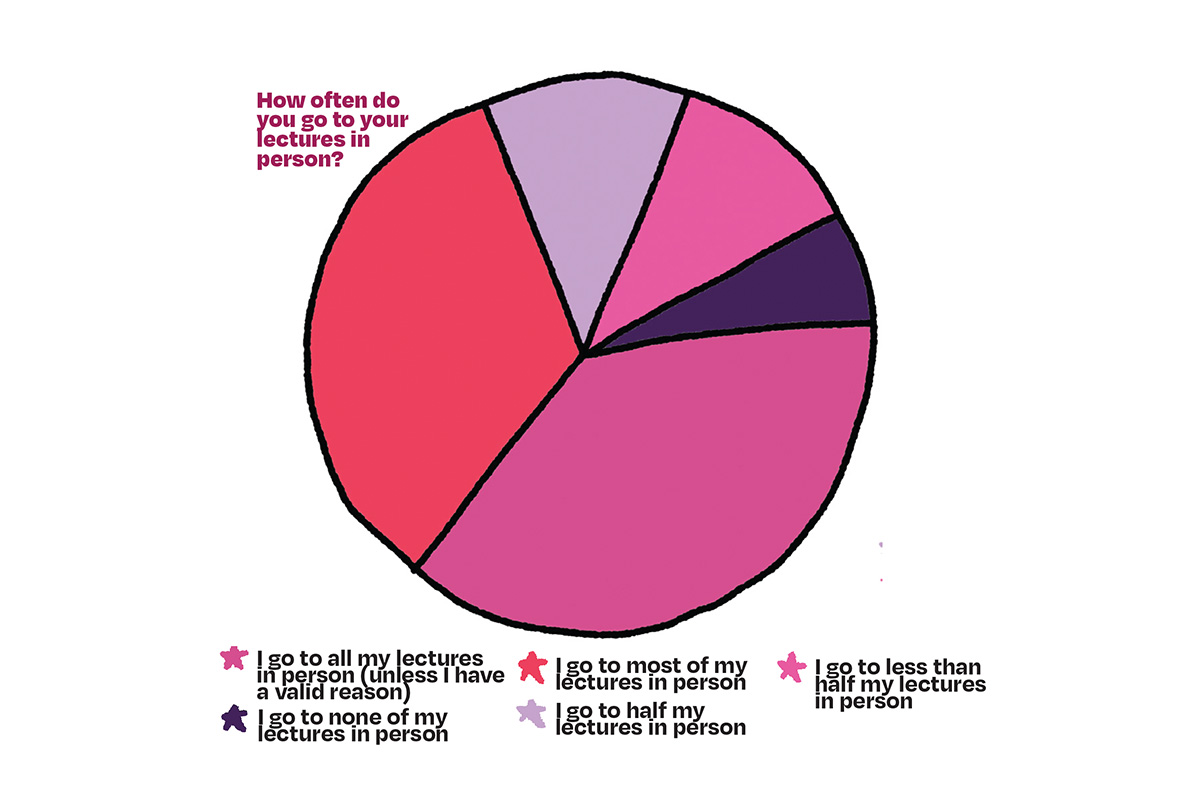
Grant Robertson’s Performance
It’s been a year since Grant Robertson stepped into the shoes of Vice Chancellor in July 2024. A former OUSA President (1993) and Minister of Finance from the Covid era, Grant inherited a big job: mopping up leaky university coffers, addressing rising campus unrest about Israel-Palestine, managing numerous large-scale building projects, worrying over increasing use of generative AI, heading a rebranding of the university, and shushing a student magazine pestering him about its 100-year birthday.
When Grant took the role last year, students in the census were largely apathetic about the appointment – 50.6% felt neutral, 7.4% disapproved and 42% were in support. This year, Critic Te Ārohi asked students how you’ve rated his efforts, hoping that if you didn’t know him from his title, then you’d recognise the jolly guy from the University’s Instagram videos. The 348 students who answered gave him an average rating of 3.66 out of 5 (39.4% ranking him four stars). The one star cohort are either salty about him raising tertiary fees last year or found out he’s from Palmy.
Technology
ChatGPT
In just a few years, ChatGPT has turned into the students’ – and lecturers’ – best friend. Able to chew up data and spit out an essay or course outline in a matter of moments, there’s been widespread nervousness about its implications in tertiary education.
Otago Uni’s policy on the use of generative AI says ChatGPT can be used as a tool for learning and research, but relying on it for assignments is considered academic misconduct. 23.3% abstain from ChatGPT use, 43.2% do occasionally (the academic equivalent of social smoking) and 33.5% openly admitted to using it often – an increase from the 25.6% who had last year. Its primary use is as an assignment-planning tool (69.3%) to provide a structure or work through brain block. The second highest use was as a search engine (59.9%), and the third was to edit assignments (50.7%). Other creative uses for ChatGPT include marking work based on a marking schedule, simplifying difficult concepts (the new “[insert concept] for kids” Google search), coding, summarising readings or, in a bleak Black Mirror twist, as a therapist.
Exams
Given the threat of AI to academic integrity, universities are forced to doubly ensure that students’ work is their own. You wouldn’t want to be represented by a lawyer or treated by a doctor who graduated based on AI-essays, after all. In the census, only 10% thought all exams should be digital. A majority of students (62.3%) thought only some exams should be digital, and 15.7% of students voted that all exams should be handwritten.
Social Media
Hopes for escaping brain rot and touching grass were dashed in the results for social media use. Half of respondents spent at least ten hours on their phone a week, with a big chunk (28.5%) spending 20 or more hours doom-scrolling on Instagram reels (the most popular social media app). Somewhat surprisingly, Facebook beat TikTok in popularity – perhaps due to the options it provides: marketplace finds, clicking article links (a girl can dream), stalking your high school friend’s Greece trip photo dump, or plotting the perfect 21st event description. Kudos to the same four people from last year who raw dog life without social media.
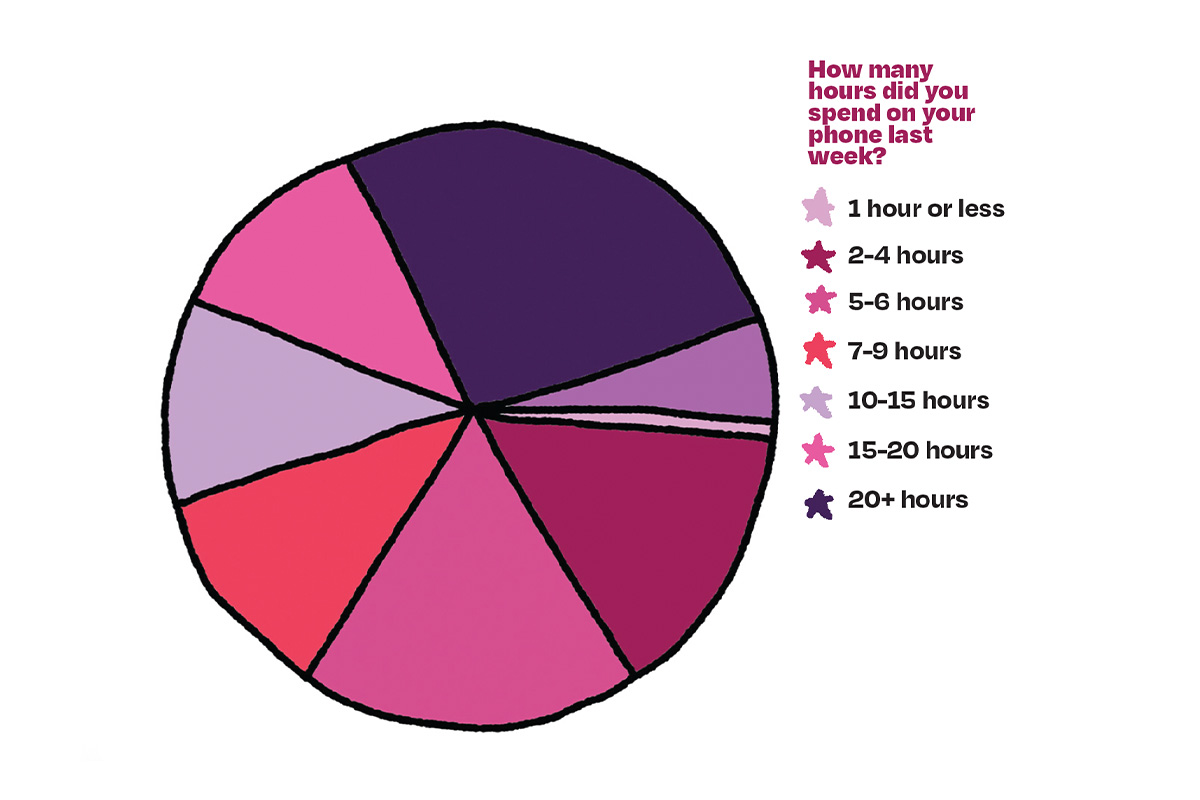
Party Culture
Alcohol
In a country of boozers to the point of having a national day for sinking a crate, Dunedin is proudly patriotic. Students reliably ranked drinking habits similarly to last year, with a similar proportion of students reckoning they drank less than their peers (42.7%) as the number who thought they were on par with their peers (37.4%). 10% proudly clicked “more” while 9% didn’t drink at all. Compared to stats from the first Critic census in 2021, there was a higher proportion of students who drank less, less who were the same, and slightly less who drank more than their peers. Either Dunners is losing its touch or there’s simply more drugs on the scene.
Drugs
Dunedin might be one of the few cities where weed is practically legal and drones are dropping baggies at flat’s doorsteps. The drug trends over the years have remained fairly consistent: weed reigns supreme (72%) and MDMA is its loyal sidekick (39.9%). Over the years, spot number three has been contested – nangs were ousted by Ritalin last year, where it remains in 2025 (21%). Since last year, there’s been a slight uptick in Ketamine use (go horsie, go!), surpassing both shrooms and acid in popularity. Other weird shit students have been getting high on includes 2CB, salvia, and dexys that did “NOTHING”.
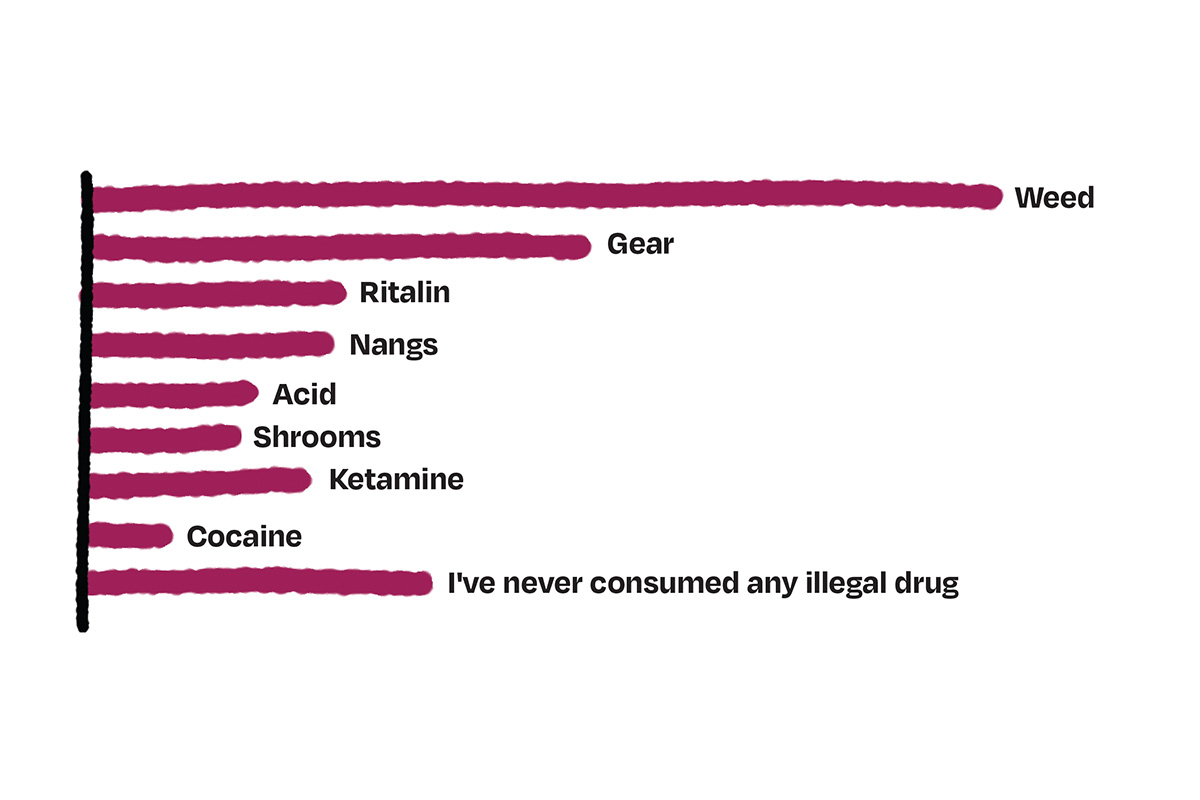
Going Out
The beauty of living within 100 metres of your best friends is having endless options for pres. But when you aren’t testing the structural integrity of your crusty flat’s walls with thumping DnB and actually make it to town, where’s hot? Subs kept its top spot, alluring crowds of students with toast time and foam parties (18.4%). Catacombs climbed from fourth to second this year, raking in 14.8% of votes. Vault 21 dropped from second to third (10.3%). Carousel copped fourth (9.7%) a popular haunt for house fiends and those who “socially” smoke cigarettes (32.3%), with less reaching for a vape on a night out (23.9%). Admittedly we missed gig venues and stuck to Octagon clubs, so apologies to U-Bar or Crown diehards – where the 36 students who punch darts on the reg can probably be found leaning against the building.
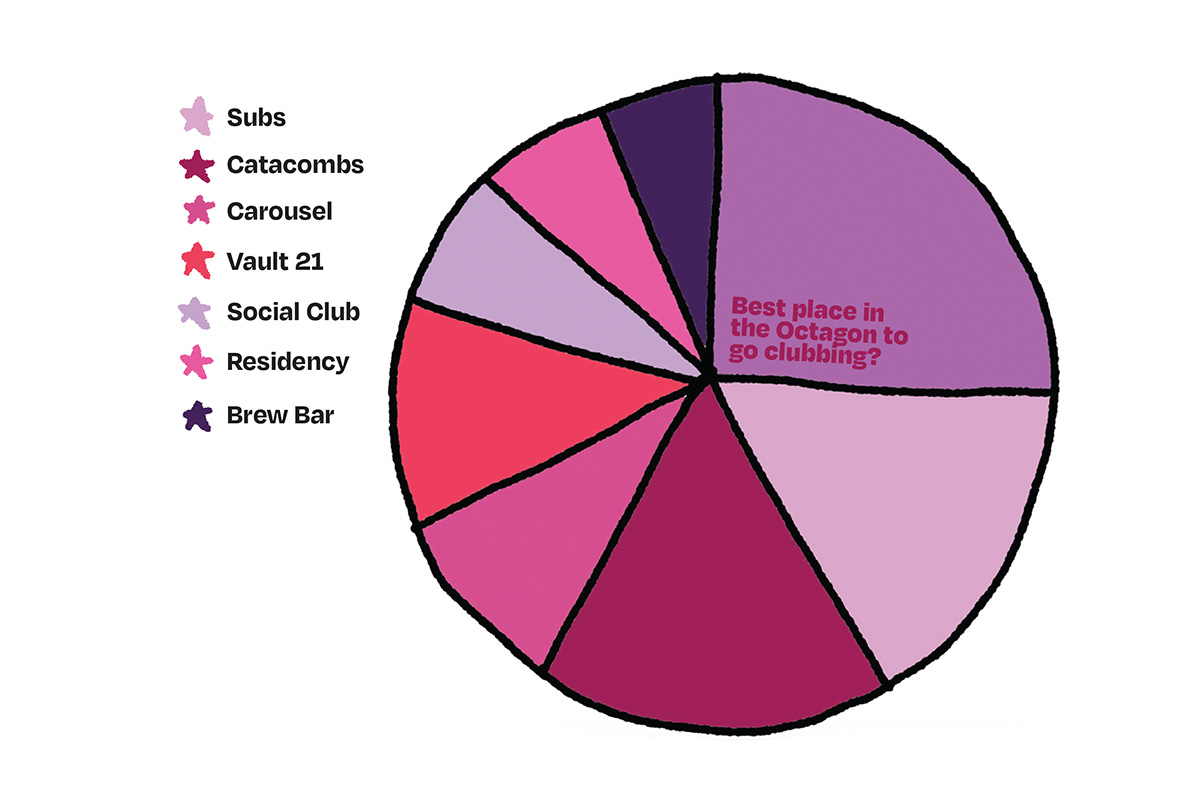
Flatting
Dunedin is often described as a “student city” where most students reside shoulder-to-shoulder (61%) and flatmates can become like family. The most harmonious flats were born out of pre-existing relationships. Both first-year hall mates and groups of high school besties described their relationship as being either “borderline codependent” or simply living well as a group. Friend of friends or Facebook marketplace flatties had mixed results – some describing neutral cohabitation, hanging out a home while retaining separate social lives, others “a house divided” – and flatting with strangers seemed more likely to make for an awkward living situation. Higher phone use is interestingly correlated with a more divided flat dynamic. Critic unearthed some drama in the comment section, with perhaps the juiciest answer being: “I love four of my flatmates to bird [sic] and we are good at living with each other, but the other two are psychopaths and need a reality check before they get curb stomped.” Yikes.
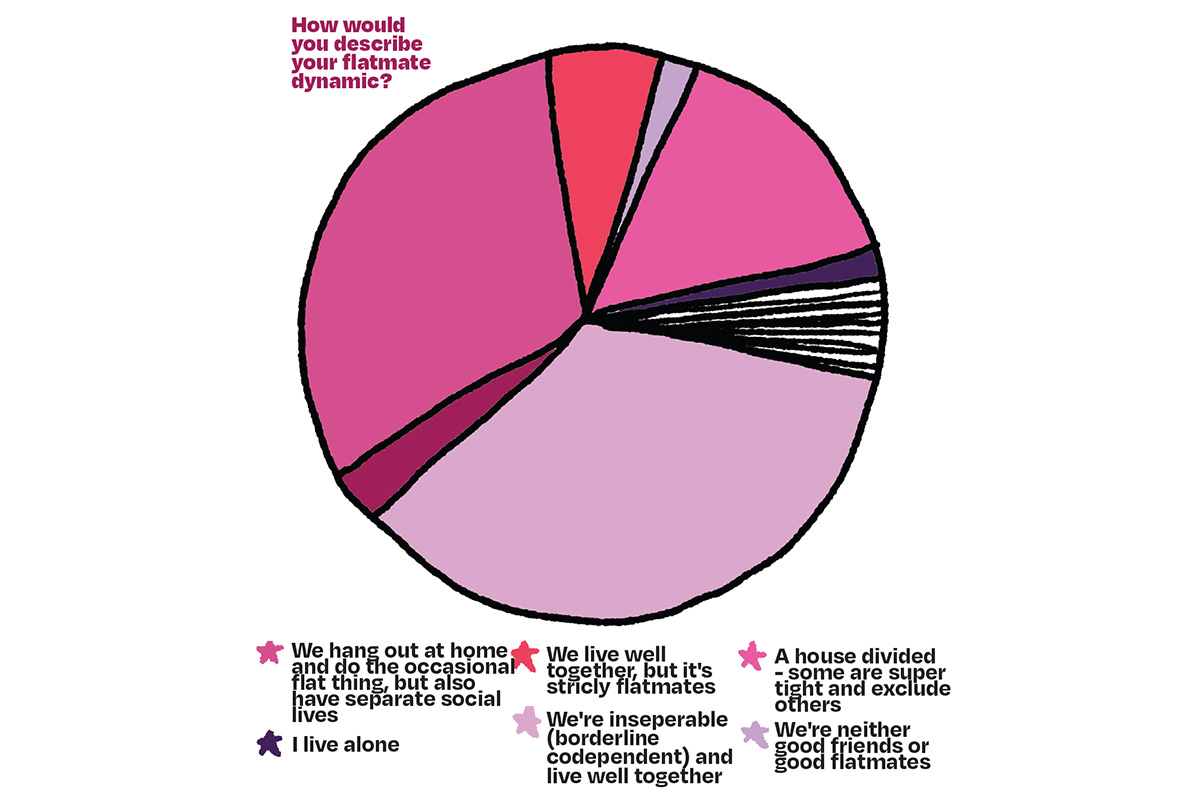
There’s nothing quite like the adrenaline rush of glancing at a flat group chat notification starting with “hey guys, can we please…” What’s the beef in flats? Dishes racked up the top spot (68%) – triggering flashbacks of pans left to “soak” and mouldy month-old coffee mugs. Next was rubbish (32.2%), power usage (28%), noise-levels (18.8%), fridge space (16.3%), laundry (14.4%), bills (12.5%), visitors (10.9%) and car parking (5%). Individualised answers included not hanging up the bathmat, trauma dumping, locking the front door, general tidiness, and flatcest (tea). To the person whose flatmate keeps pissing on the floor: thoughts and prayers.
Politics
Political leaning
Tertiary campuses have a reputation for being liberal, progressive spaces, and it seems Otago is no different. Half placed themselves on the left, and a further 18.9% went far left. A similar proportion of students were either central or unsure (12%), 5.7% were right-leaning, and only two students considered themselves to be on the far right.
For newly minted voting citizens of New Zealand, only half of students said they felt that any political party represented their views. Most students indicated that they would vote for the Greens (51%), with one person listing Chloë Swarbrick as one of their main sources of trusted information. The next most popular parties were Labour (16.2%), Te Pāti Māori (6%), National (5.3%) (one second-year girl said she voted National but regretted it, “sorry girls”) and The Opportunities Party (4.4%). Reasons for those who abstained ranged from a claim that voting is for communists (unsure they understand the concept), another claimed to “hate all of them equally” and one person wished they could vote for Trump. MAGA man also thought unemployed people who spend all their time protesting “could be doing more important stuff”.
Representation & the Government
The current government is a right-wing coalition between the National Party, ACT, and NZ First who have slowly been working down their list of “objectionable” things Labour did and reversing them. 84.3% of students said they didn’t like the current government, a higher level of dissatisfaction compared to last year’s 73%. Distrust in the government could be related to any number of bills hurting the tertiary sector, but overwhelming opposition to the controversial Treaty Principles Bill (73.4%) was almost certainly a factor. Those who somewhat or strongly supported the Treaty Principles Bill were either ACT or National voters, with one Green outlier. Unsurprisingly, none of those who supported the bill felt represented by the OUSA Exec, who earlier this year submitted in opposition to it. One of them was one of the two people who subscribed to pastafarianism (religion of the Flying Spaghetti Monster).
Biggest issue facing our generation
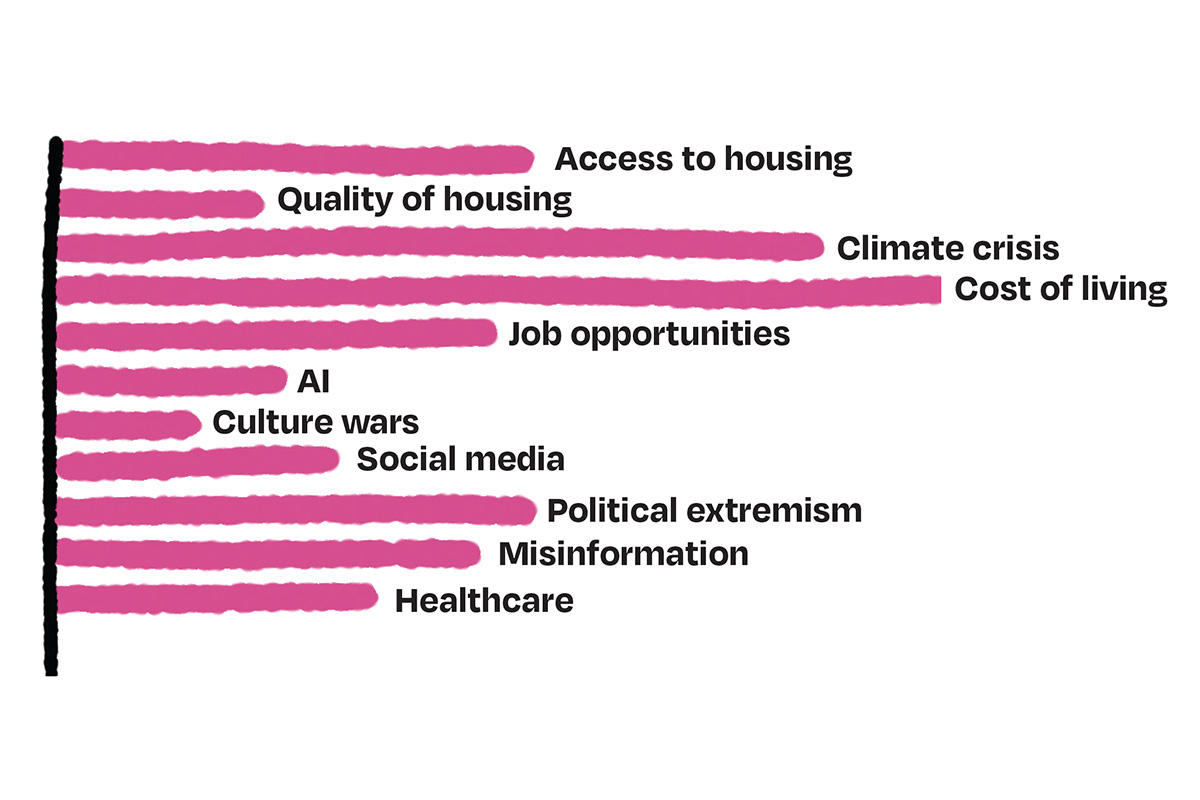
Students could be forgiven for feeling glum about the state of the world given the threat of World War 3, backsliding promises on climate protections, a flailing job market, struggling healthcare system, and the rise in misinformation – all accessible from the comfort of our mould-riddled flats. But what takes the cake?
At O-Week’s Tent City, the Exec discovered that the biggest issue on students' minds was the cost of living, and the census showed the same. Students’ worries are consistent with a broader trend in Aotearoa, with a recent Ipsos NZ survey (a track of issues most important to Kiwis and the political parties best able to manage them) discovering that out of 1000 Kiwis, 55% consider cozzie livs to be the biggest issue. Among students, the proportion was higher, with 78.7% listing cost of living in their top three concerns.
The next biggest issues on students’ brains were the climate crisis (55.2%), access to housing (34.4%), political extremism (33.9%) and job opportunities. Individualised answers included a decent helping of existential angst, with many students wishing for a “fucking all of them” option (one in all caps). Other additions to the cesspit of issues included overseas emigration, the “radicalisation” of youth, political correctness, lack of connection to Mother Earth, racial equality, and critical thinking. To sum it all up, one student said their biggest worry was, “Lack of a truly killer soundtrack to go with all this political turmoil. The Clash can only be stretched so far, ya know?”
To navigate it all, we asked students where you’re turning to for accurate political information. Many students said they didn’t fully trust any of them, but out of the presented options mainstream news outlets were your most trusted source (69.2%). Student media came second (44.6%) with Critic Te Ārohi scoring 67% of students who reckoned we maintain high standards of journalistic integrity, and plenty of slaps on the wrist for mistakes that have eroded trust (always learning). Social media (37.7%) and university lecturers (38.2%) were about on par in students’ eyes, and politicians came in last (18.4%). One person just relies on this guy called Zeth for their information.
Rent
The biggest chunk of change students need to afford week to week is rent. The average price is similar to last year, a third paying between $160 and $190, and another between $190 to $210. No matter the suburb, there was a middling average of around $190, with wide gaps even within suburbs. While some in North Dunedin are paying pennies (~$125) in those “character-building” historic homes, others just blocks away are paying up to $275. Both probably have even odds of passing Healthy Homes standards. Central Dunedin has the most stable middle range of rental prices and the bougie students could be found dotted around the flashier Pine Hill or St Clair, happily paying for their refuge away from midnight yelling and breaking bottles.
Finances
To make ends meet in a cost of living crisis, only 23.5% of students are eligible for the student allowance. Students are also relying on the support of their parents for occasional small expenses (52.1%), rent/hall fees (25.8%) or weekly groceries (15.1%). 54.5% of students have a part-time job, 86 of whom have more than one. Distribution by industry was education (22.3%), hospitality (19.3%), retail (18%), customer service (10.2%), supermarket (7.2%), fast food (5.6%), events (4.8%), media (4.8%) and cleaning (4.8%).
Unpopular Opinion
In a debut question this year, Critic asked you for your unpopular opinion. With 235 responses to comb through, it made for an entertaining read that left us equally impressed and concerned. Answers could be categorised under political commentary, random shower thoughts, and hot takes, with an extreme range that can be best encapsulated by one answer: “Pineapple belongs on pizza. Bring back the death penalty.” We couldn’t include them all, but here’s a highlight reel: disagreements over whether people with differing political beliefs can be friends, an endorsement of Winnie P staying in Parliament “because he’s absolutely hysterical”, a love confession for Maggi noodles, someone who snacks on milk powder, people going back to “dumb phones”, someone who reckons being into true crime is “icky”, big forehead and peasant living fetishes, opinions that being tipsy is more fun than being drunk and that “microwaves aren’t as important as everyone says”, distaste for wearing Uggs on campus, “bitches hate nuance” and a second-year who “really just can’t get behind furry culture”.
OUSA
OUSA
The Otago University Students’ Association (OUSA) is responsible for almost everything on campus outside of your studies and UniPol membership. From your first experiences at Toga Party at Ori’ to resolving flat dramas with Student Support, to browsing student entrepreneurial stalls every other market day or reading a copy of Critic over a $4 curry and listening to Radio One in Clubs and Socs – it’s all OUSA. Historically, despite OUSA’s best efforts (and Critic’s) there’s been a shroud of confusion in the difference between OUSA and the Uni. This year, an optimistic two thirds of students ranked their understanding of OUSA to be between three and four out of five, with familiarity naturally increasing in older year-levels.
OUSA Exec
The Exec is the elected board of student representatives who govern OUSA. There was an even split among students who were at university last year in whether or not they voted in last year’s elections. Much like predecessor Keegan Wells, current President Liam White campaign for the top dog role was uncontested. 66.2% of students even know who he is, adorning flat walls with the Tabloid centrefold of Mr President blowing his constituents a big kiss.
Under Liam’s leadership, this year’s Exec hit the ground running, announcing it to be a “year of action” with intense planning sessions on how they would tackle their top priorities: the cost of living, student culture, welfare, housing, and education accessibility. Jury’s out on whether they bit off more than they could chew. 310 students ranked the Exec’s performance this year at 3.56 out of five. Pākeha reported the highest satisfaction with OUSA’s performance (4.33), then Asian students (3.2), Māori (2.6) and Pasifika (2.25). Asked to what extent they agreed that the Exec represented their views, the three biggest chunks said they agreed (33.2%), were neutral (28%) or simply didn’t know (27.5%).
OUSA $4 lunch – “frunch”
Cost of living listed as the chief concern among students, but not nearly enough are making the most of frunch in the Clubs and Socs building. To the 65% who are missing out and surviving on two-minute noodles: a cheap curry, pasta or soup is the light at the end of the tunnel. 15.3% have cottoned on to the $6 butter chicken, a more bougie option. Crunching the data confirmed Critic’s suspicions that there is a correlation between those who’re part of extracurricular clubs and frequent frunch (AKA ski bums who are trying to petrol back and forth from Wanaka all season). Wednesday’s dal makhani with rice and potato curry retained its top spot (5.6%) and Thursday’s soup remained at the bottom (2.8%).
Thank you dearly to everyone who dished the details of your lives and offered your opinions for the fifth Critic census. And that’s the tea.


